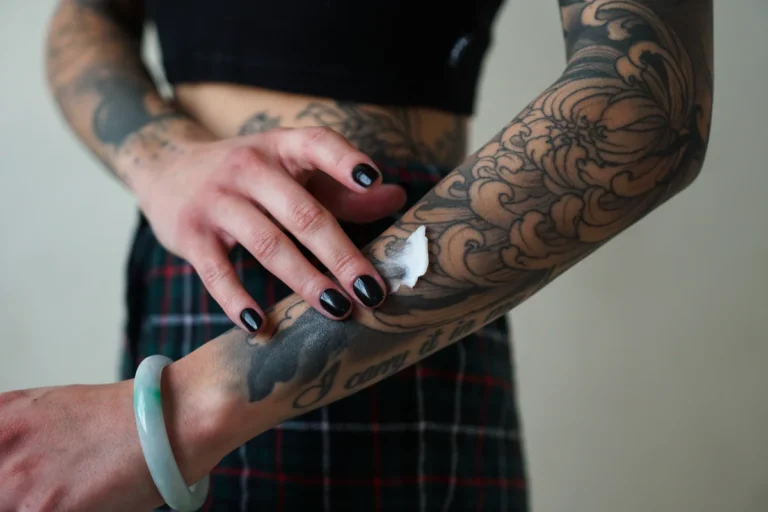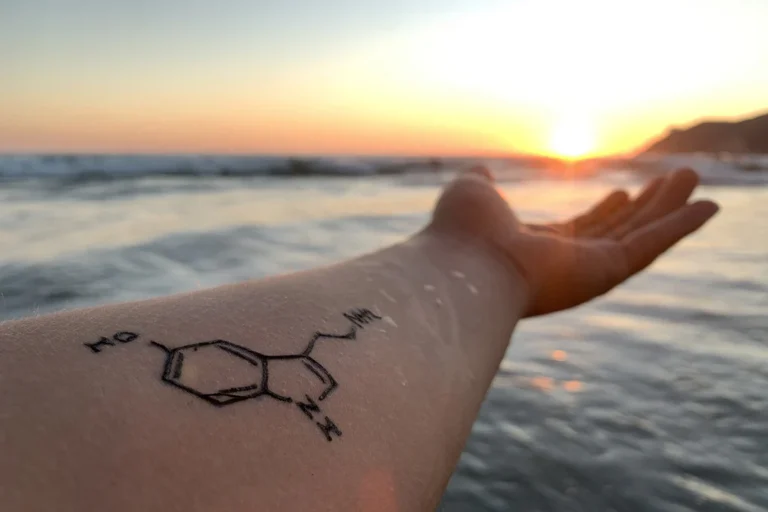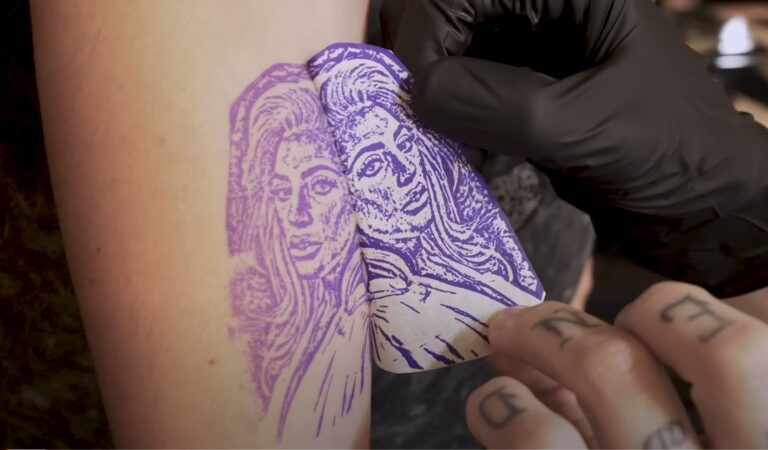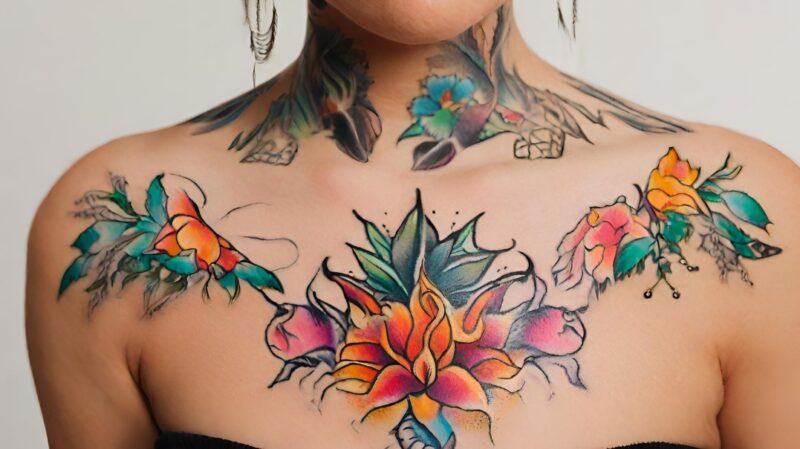Tattoos have become a widely embraced form of self-expression and art.
Among the many styles available, color tattoos are particularly notable for their vibrant and creative designs.
We’ll cover everything you need to know about color tattoos, from the fundamentals to aftercare tips.
Color Tattoos
Color tattoos utilize a wide array of colored inks to craft intricate and vibrant designs that stand out on the skin.
These tattoos are known for their ability to bring a design to life, offering a level of detail and dimension that can be more challenging to achieve with traditional black and grey tattoos.
Unlike black and grey tattoos, which rely on shading and contrast to create depth, color tattoos use a spectrum of hues to add richness and realism or to evoke a fantastical, surreal quality.
The versatility allows for a broad range of styles, from photorealistic portraits and nature scenes to whimsical and abstract artwork.
The choice of colors in a tattoo can greatly influence its overall effect. Subtle pastels can provide a soft, delicate appearance, perfect for floral designs or gentle landscapes.
On the other hand, bold, bright hues can make a tattoo pop, creating a striking and eye-catching piece of body art.
Bright reds, blues, yellows, and greens are often used to create vibrant and dynamic images that demand attention.
Types of Color Tattoos
There are various types of color tattoos, each with its own style and technique. Some popular types include:
| Tattoo Style | Description |
|---|---|
| Realistic | Replicates real-life imagery with accurate shading and color. |
| Watercolor | Soft, flowing colors inspired by watercolor paintings. |
| Traditional | Bold outlines with a limited but bright color palette. |
| Neo-Traditional | Builds on traditional art with more details and a broader color spectrum. |
| Blackwork | Solid black ink with intricate patterns or geometric designs. |
| Dotwork | Uses tiny dots for shading and texture. |
| New School | Vibrant colors and exaggerated, cartoonish designs. |
Choosing the Right Design
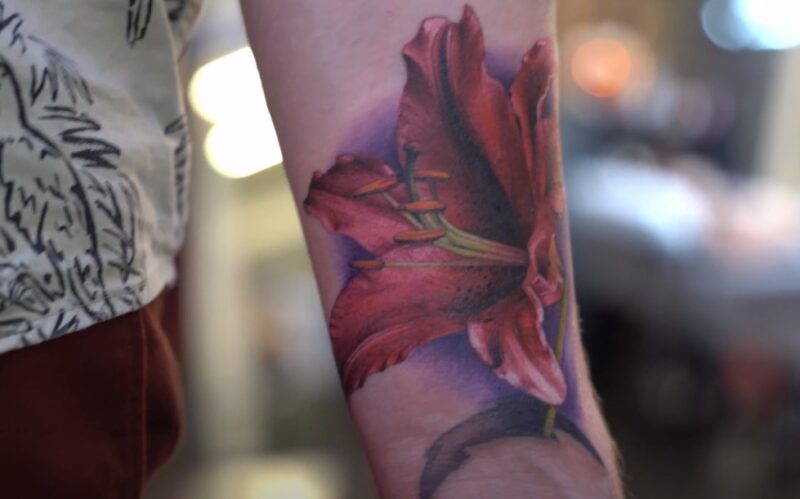
Selecting a design for a color tattoo involves considering personal style, the meaning of the tattoo, and how it will age over time.
It’s important to choose a design that you’ll be happy with for many years.
Working with a Tattoo Artist
Collaboration with an experienced tattoo artist is crucial.
They can help refine your ideas, suggest suitable color schemes, and ensure the design fits well on your body. Look at their portfolio to understand their style and expertise with color tattoos.
Preparing for the Tattoo Session
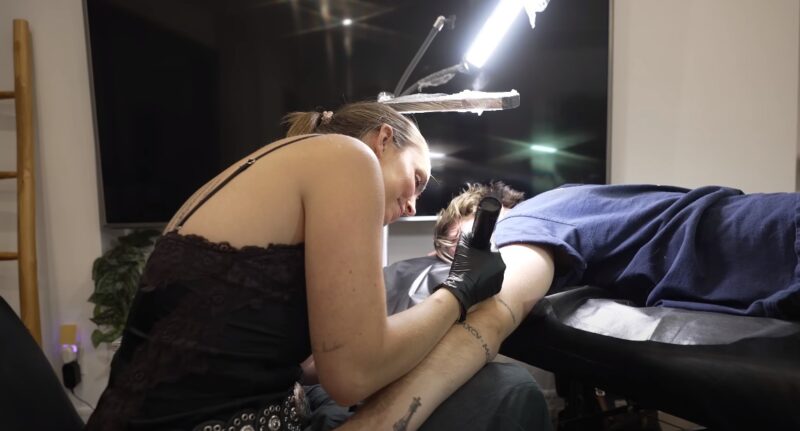
Before getting a color tattoo, you need to prepare both mentally and physically. Ensure you’re well-rested, hydrated, and have eaten a meal.
Avoid alcohol and blood thinners before your appointment.
Tattoo sessions can vary significantly in length, largely depending on the size, complexity, and detail of the design. For color tattoos, the duration can be longer than that for black and grey tattoos due to the additional steps involved in layering and blending colors to achieve the desired effect.
What to Expect During the Session
Here’s a breakdown of what you can expect during your color tattoo session:
1. Preparation
Before the session begins, your tattoo artist will discuss the final design with you, ensuring that all details are confirmed.
This is also a good time to ask any last-minute questions or express any concerns you might have.
The artist will clean and shave (if necessary) the area where the tattoo will be applied to ensure a smooth surface.
A stencil of the design is usually applied to the skin to serve as a guide.
2. Outlining
The session often starts with outlining the tattoo using black ink. This step is crucial as it defines the basic structure and details of the design.
This part of the process may be relatively quick compared to the coloring stage, but it can still take some time depending on the intricacy of the design.
3. Coloring and Shading
This is where color tattoos differ significantly from black and grey tattoos. Applying color involves multiple passes to layer and blend the inks, creating depth and vibrancy.
The artist will work with different colors, carefully shading and blending to achieve the desired look.
This can be a meticulous process, requiring precision and patience.
Due to the layering of colors, the artist might need to let one layer of ink settle before applying another, adding to the session’s length.
4. Breaks
Depending on the length of the session, there will likely be breaks. This allows both you and the artist to rest.
It’s important to stay hydrated and eat a light snack during these breaks to maintain your energy levels.
5. Discomfort and Pain Management
Expect some discomfort during the tattooing process.
The level of pain can vary based on the location of the tattoo, your personal pain tolerance, and the technique of the artist. It’s essential to communicate with your artist if the pain becomes too intense.
They can adjust their technique, take more frequent breaks, or suggest ways to help manage the discomfort. Many artists recommend deep breathing or other relaxation techniques to help manage pain.
Aftercare for Color Tattoos
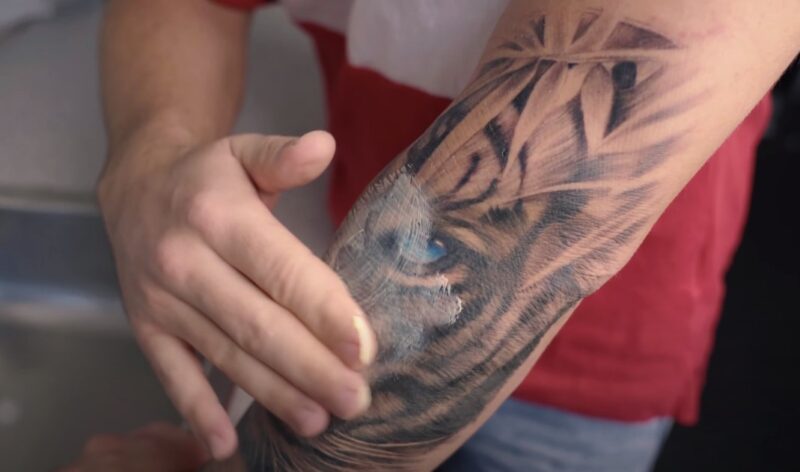
Proper aftercare is crucial for the longevity and vibrancy of your color tattoo.
Your artist will provide specific instructions, but general guidelines include:
| Aftercare Step | Description |
|---|---|
| Keep it clean | Wash with fragrance-free soap. |
| Moisturize | Use fragrance-free moisturizer. |
| Avoid sun exposure | Keep out of sunlight and use high SPF sunscreen. |
| Avoid soaking | Avoid baths, pools, or hot tubs until healed. |
| Wear loose clothing | Wear breathable, loose clothing. |
| Avoid picking or scratching | Don’t pick at scabs or scratch. |
Healing Process
The healing process for a tattoo can take several weeks, and it typically occurs in stages. Initially, your tattoo may be red, swollen, and tender to the touch. Over the first few days, you may notice oozing of plasma and ink. It is a normal thing to expect, do not be afraid of it.
As your tattoo begins to heal, it will start to scab and peel. During this stage, it’s crucial to keep the area clean and moisturized. It’s normal to experience itching, but avoid picking at scabs or scratching the tattoo, as this can cause infection and damage the design.
Around weeks two to three, most of the scabbing should subside, and the peeling will lessen. Your tattoo may appear dull or cloudy as the outer layers of skin heal, but this is part of the normal healing process.
Risks and Considerations
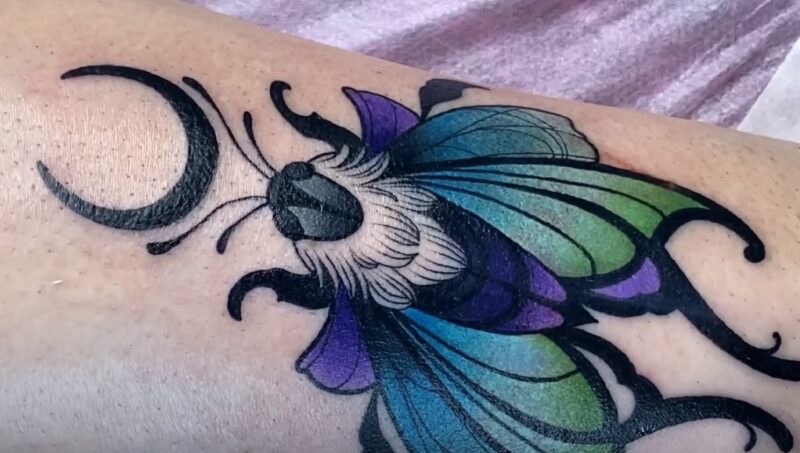
Color tattoos, like any tattoos, come with certain risks that you should be aware of before getting inked. One of the primary risks is an allergic reaction to the tattoo ink.
Some people may have sensitivities to certain pigments, particularly bright colors like red and yellow, which can cause itching, swelling, and discomfort.
If you have a history of allergies, it’s advisable to discuss this with your tattoo artist and possibly conduct a patch test.
Infections are another significant risk associated with tattoos.
To minimize this risk, it’s crucial to choose a reputable studio that adheres to strict hygiene standards.
The tattoo artist should use sterilized equipment, wear gloves, and provide aftercare instructions to help you care for your new tattoo properly. Ensuring the studio is clean and the artist is experienced can significantly reduce the risk of infection.
Other considerations include the potential for scarring if the tattoo doesn’t heal properly or if you pick at scabs during the healing process. Additionally, certain areas of the body may be more prone to complications due to movement, friction, or difficulty keeping the area clean.
Longevity and Fading
Color tattoos can fade over time, and several factors contribute to this process. Sun exposure is one of the primary culprits, as ultraviolet (UV) rays can break down the pigments in the ink, causing them to fade.
To preserve the vibrancy of your tattoo, it’s essential to keep it out of direct sunlight or use a high SPF sunscreen whenever the tattoo is exposed.
The type of ink and the specific colors used can also affect how quickly a tattoo fades. Some colors, like red and yellow, are more prone to fading compared to others. Lighter shades may require more frequent touch-ups to maintain their appearance.
The location of the tattoo on your body can impact its longevity as well. Tattoos on areas that experience a lot of friction or movement, such as the hands, feet, or joints, may fade faster than those on more static parts of the body.
Regular touch-ups are often necessary to keep your color tattoo looking its best. Most tattoo artists offer touch-up services, especially if they did the original work. Maintaining proper aftercare, such as moisturizing and protecting your tattoo from harsh environmental factors, will also help preserve its vibrancy over time.
Final Words
Color tattoos offer a beautiful and expressive way to showcase art on your body.
By being aware of the process, choosing the right design, and following proper aftercare, you can ensure your color tattoo remains vibrant and meaningful for years to come.
Remember to always consult with a professional tattoo artist to get the best results.
Related Posts:
- Tattoo Designs 101: Everything You Need to Know
- Tattoo Sizing Guide: Knowing What You Want
- Can You Remove A Tattoo At Home? Erase the Past
- Tattoo Aftercare Steps You Must Follow for Perfect Healing
- Latest Trends in Geometric Tattoos - What's Hot in 2024?
- 10 Tips on How To Protect Your Tattoos from the Sun



